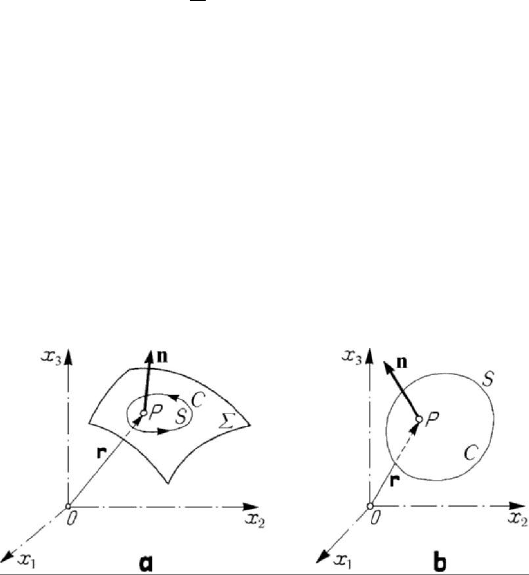Teodorescu P.P. Mechanical Systems, Classical Models Volume I: Particle Mechanics
Подождите немного. Документ загружается.

MECHANICAL SYSTEMS, CLASSICAL MODELS
724
2.3.1 Continuous systems of vectors
Let be a continuous system of vectors
{
}
V , which may be bound or sliding ones;
assuming that at any point
P
, of position vector r , belonging to a domain
D
, is
applied a vector
dτV , we may consider the vector field ()
=
VVr, proportional to the
volume element
dτ
at any point of the domain. We introduce the resultant
R
of the
system of vectors in the form of a free vector, given by
()d
D
τ=
∫∫∫
RVr
(A.2.59)
and the resultant moment, as a bound vector, applied at the pole
O and given by
()d
O
D
τ=×
∫∫∫
MrVr; (A.2.60)
thus, we obtain the torsor
{}
{
}
,
OO
τ
=VRM of the continuous system of vectors.
The components of the resultant
R are given by
()d
ii
D
RVτ=
∫∫∫
r , 1, 2, 3i
=
, (A.2.59')
while the components of the resultant moment
O
M are written in the form
()d
i
j
Ox ijk k
D
MxVτ=∈
∫∫∫
r , 1, 2, 3i
=
. (A.2.60')
A continuous system of sliding vectors
{
}
V is equivalent to zero if and only if its
torsor with respect to an arbitrary pole is equal to zero (condition (2.2.25)); this
condition is only necessary in the case of a continuous system of bound vectors. Taking
into account (A.2.59') and (A.2.60'), it results that this condition is equivalent to six
equations of projection on the three axes of co-ordinates. As well, two continuous
systems of sliding vectors
{
}
V
and
{
}
′
V are equivalent if and only if their torsors
with respect to the same arbitrary pole are equal (condition (2.2.26)); this condition is
only necessary in the case of a continuous system of bound vectors.
Analogous considerations can be made, in particular, for a continuous system of
parallel or coplanar vectors. Let be, for instance, a continuous system of parallel
vectors, the direction of which is specified by the unit vector
u ; we may write
() ()V
=
Vr ru, (A.2.61)
where
()V r represents the component of the vector ()Vr along the given direction. If
()d
D
VVτ=
∫∫∫
r , (A.2.62)
then we obtain the resultant

Appendix
725
V
=
Ru; (A.2.62')
if
0V ≠ , then we put in evidence the centre C of the continuous system of parallel
vectors, specified by the position vector
=
∫∫∫
rr
1
()d
D
V
V
τρ . (A.2.63)
The properties emphasized for the point
C remain valid for a continuous system of
vectors too.
2.3.2 Stokes’ formula
Let be a closed curve
C , situated on the sufficiently smooth surface Σ , limiting on
it a simply connected domain
S (reducible – by continuous deformation – to a point,
without leaving the surface
Σ ) (Fig.A.4,a). The surface Σ is oriented by means of the
unit vector
n of the normal to it; as well, we assume a direction of travelling through
the curve
C . Let us consider the vector mapping
123 123
(, , ) (, , )xxx xxx→ V , with
1
()CD∈V , where D is a domain which includes SC
+
. One may prove Stokes’
formula
Figure A.4. The Stokes formula (a). The Gauss-Ostrogradskiĭ formula (b).
dcurld
CS
S⋅= ⋅
∫∫∫
v
Vr n V; (A.2.64)
because the left member of the formula depends only on the curve
C , we may replace
the surface
S by any other surface
0
SD⊂ , which satisfies analogous conditions.
As we have seen in Subsec. 1.1.4, the curvilinear integral is called circulation (it
represents the work of a field of vectors), while the surface integral represents the flux
of a field of curls; in the above mentioned conditions, it results that the circulation of a
field of vectors along a closed curve is equal to the flux of the curl of the very same
field of vectors through a sufficiently smooth arbitrary surface, bounded by the given
curve. We also mention that the circulation of a field of irrotational vectors, hence of a
field of conservative vectors, vanishes. With respect to the orthonormed frame of
reference
123
Ox x x , we may write

MECHANICAL SYSTEMS, CLASSICAL MODELS
726
,
dd
ii i
ijk k j
CS
Vx nV S=∈
∫∫∫
v
; (A.2.64')
in particular, if
1
1
()VFCD=∈ ,
23
0VV
=
= , then it results
(
)
12,33,2
dd
CS
Fx nF nF S=−
∫∫∫
v
. (A.2.65)
If in Stokes’ formula (A.2.64) we concentrate all the surface at a point of position
vector
r , then we get
0
d
pr curl curl lim
C
S
S
→
⋅
=⋅ =
∫
v
n
Vr
Vn V
. (A.2.66)
Hence, we may determine the projection of the vector
curl V on an arbitrary axis of
unit vector
n (hence the very same vector), without any reference to a frame; thus, the
definition given to the curl in Subsec. 2.2.1 has an intrinsic value, being immaterial on
the frame.
2.3.3 Gauss-Ostrogradskiĭ formula
Let be a sufficiently smooth closed surface
S , limiting a domain D , and a field of
vectors
()
=
VVr (Fig.A.4,b); we assume that
1
()CD S∈+V . We may write the
Gauss-Ostrogradskiĭ formula in the form
ddivd
SD
S τ⋅=
∫∫ ∫∫∫
Vn V , (A.2.67)
where
n is the unit vector of the external normal to the surface; the surface integral
represents the flux of the field of vectors through the surface
S
, so that the formula is
called the flux-divergence formula too. The flux of a solenoidal vector vanishes. In the
orthonormed frame
123
Ox x x
we obtain
,
dd
jj jj
SD
Vn S V τ=
∫∫ ∫∫∫
. (A.2.67')
In particular, if we consider the component
1
()
j
VFCDS=∈ +, the other
components vanishing, we may write
,
dd
jj
SD
Fn S F τ=
∫∫ ∫∫∫
, 1, 2, 3j
=
; (A.2.68)
multiplying by the unit vector
j
i and summing, we get
dgradd
SD
FS Fτ=
∫∫ ∫∫∫
n . (A.2.68')
If we take
F of the form
j
ijk
V∈ in (A.2.68), we obtain

Appendix
727
,
dd
j
ijk k ijk k
j
SD
nV S V τ∈=∈
∫∫ ∫∫∫
,
so that
dcurld
SD
S τ×=
∫∫ ∫∫∫
nV V . (A.2.69)
Let be a domain
DD
′
⊂ , reducible by continuous deformation to a point of
position vector
r and S
′
the surface (sufficiently smooth) which bounds it. Starting
from the Gauss-Ostrogradskiĭ formula (A.2.67), we may represent the divergence of the
vector
V in the form
0
d
div lim
S
D
S
D
′
′
→
⋅
=
′
∫∫
Vn
V
; (A.2.70)
hence, the definition given in Subsec. 2.2.1 is immaterial of the frame and has an
intrinsic value.
2.3.4 Green’s formulae
The formula (A.2.67) leads to
dd
SD
U
SU
n
Δτ
∂
=
∂
∫∫ ∫∫∫
(A.2.71)
for a field of conservative vectors of the form (A.2.33'), where we took into account
(A.2.6') and the definition of Laplace’s operator. If
=
VWψ ,
123
(, , )xxxψψ=
scalar, then we may write
d(div grad)d
SD
Sψψ ψτ⋅= +⋅
∫∫ ∫∫∫
Wn W W , (A.2.72)
where we used the property ii) of the divergence. If, after this, we take
gradϕ=W ,
123
(, , )xxxϕϕ= scalar, then we get
d ( grad grad )d
SD
S
n
ϕ
ψψΔϕϕψτ
∂
=+⋅
∂
∫∫ ∫∫∫
; (A.2.73)
inverting
ϕ and ψ and subtracting the relation thus obtained from (A.2.73), it results
(
)
d( )d
SD
S
nn
ϕψ
ψϕ ψΔϕϕΔψτ
∂
∂
−= −
∂∂
∫∫ ∫∫∫
. (A.2.74)
The formulae (A.2.71), (A.2.73) and (A.2.74) are known as Green’s formulae.

MECHANICAL SYSTEMS, CLASSICAL MODELS
728
2.3.5 The differentiation formula for integrals which depend on a parameter
We consider, in what follows, integrals of functions which depend on a parameter
t ,
very useful in applications. Let thus be the curvilinear integral on the curve
C
123
(,, ;)d
ii
C
C
IFxxxtx≡
∫
, (A.2.75)
where
i
F , 1, 2, 3i = , are functions of class
1
C on the domain of definition, with
respect both to the variables
j
x , 1, 2, 3j
=
, and to the time t ; we have
=
∫
123
d
d
(,, ;)d
dd
C
ii
C
I
Fx x x t x
tt
. (A.2.75')
If
= ()
jj
xxt
,
1, 2, 3j = , then we may calculate the total derivative under the integral
operator.
Analogously, for the surface integral
≡
∫∫
123
(, , ;)d
S
S
IFxxxtS (A.2.76)
we may write
123
d
d
(,, ;)d
dd
S
S
I
Fx x x t S
tt
=
∫∫
. (A.2.76')
We notice that both the curve
C and the surface S may be open or closed.
For the volume integral
123
(,, ;)d
D
D
IFxxxtτ≡
∫∫∫
(A.2.77)
we obtain, as well,
123
d
d
(, , ;)d
dd
D
D
I
Fx x x t
tt
τ=
∫∫∫
. (A.2.77')
We obtain analogous results if
S
I
or
D
I
are vectors, the functions under the integral
operator being vector functions.
If the curve
C
, the surface
S
or the volume
D
depend on the parameter
t
too,
being variable quantities, then these formulae must be completed, taking into account
the respective limits. Let thus be the volume integral
123
()
()
(, , ;)d
Dt
Dt
IFxxxtτ≡
∫∫∫
, (A.2.78)
where
()
jj
xxt
=
,
1, 2, 3j
=
and
123
ddddxxxτ
=
. By a change of variable of the
form
(
)
000
123
,,;
ii
xxxxxt= , 1, 2, 3i
=
, including the condition that the Jacobian of
the transformation be non-zero (
[
]
0
det d / d 0
ij
Jxx
≡
≠ ), we obtain

Appendix
729
(
)
()
() ()
d
d
div d div( ) d
dd
Dt
Dt Dt
I
FF
FF
tt t
ττ
∂
⎡
⎤
=+=+
⎢
⎥
∂
⎣
⎦
∫∫∫ ∫∫∫
vv
, (A.2.79)
where we have introduced the velocity
d/dt
=
vr, we used the total derivative
(A.2.9'), and we took into account the property ii) of the divergence. With the aid of the
Gauss-Ostrogradskiĭ formula (A.2.67), we may also write
()
() ()
d
d()d
d
Dt
Dt St
I
F
FS
tt
τ
∂
=+⋅
∂
∫∫∫ ∫∫
vn
, (A.2.79')
n being the external normal to the surface ()St . In the case of a vector field
()
()
(;)d
Dt
Dt
t τ≡
∫∫∫
IVr, (A.2.80)
we obtain, analogously,
(
)
()
() () ()
d
d
div d d ( ) d
dd
Dt
Dt Dt St
S
tt t
ττ
∂
=+= +⋅
∂
∫∫∫ ∫∫∫ ∫∫
I
VV
Vv vnV
. (A.2.80')
For the surface integral
()
()
(;) d
St
St
ItS≡⋅
∫∫
Vr n (A.2.81)
one may show that
()
()
d
div curl( ) d
d
St
St
I
S
tt
∂
⎡⎤
=++×⋅
⎢⎥
∂
⎣⎦
∫∫
V
vV Vvn
; (A.2.81')
by means of Stokes’ formula (A.2.64), we can write
(
)
()
() ()
d
div d ( ) d
d
St
St Ct
I
S
tt
∂
=+⋅+×⋅
∂
∫∫ ∫
v
V
vVn Vvr
. (A.2.81'')
Let be the curvilinear integral
()
()
(;)d
Ct
Ct
IFts≡
∫∫∫
r (A.2.82)
too, where
(;)tλ=rr ,
[
]
0
1
,λλλ∈ , is the parametric equation of the curve ()Ct; we
get
()
()
2
()
d
grad d
d
Ct
Ct
I
F
Fs
tt
λλ
λ
⎡
⎤
∂∂
⋅
⎢
⎥
∂
∂∂
=+⋅+
⎢
⎥
∂
∂
⎢
⎥
⎢
⎥
∂
⎣
⎦
∫
rv
v
r
. (A.2.82')

MECHANICAL SYSTEMS, CLASSICAL MODELS
730
2.3.6 Basic integral formula. Newtonian potentials
The third formula of Green (A.2.74) allows a study of Poisson’s equation. To this
goal, we write the respective formula for a function
2
()uCD∈ and for a function
1
4
v
Rπ
=
, R
=
−
ξ
r , (A.2.83)
which satisfies the equation of Laplace (excepting the point
=
ξ
r
, which is a singular
one) and represents the basic solution in the sense of the theory of distributions of
Poisson’s equation; the presence of the factor
1/4π is due to the fact that – in
distributions – we have
()vΔδ
=
− r , (A.2.84)
where
δ is Dirac’s distribution. To calculate the integrals in the formula (A.2.74), we
isolate the singular point
=
ξ
r by a sphere containing this point; the volume integral is
calculated for the domain
D without the interior of this sphere, while the surface
integral is calculated for the sphere too. If the radius of the sphere, centred at the
singular point, tends to zero, then we obtain the basic integral formula
(
)
1111
() d d
44
DS
uu
uuS
RRnnR
Δ
τ
ππ
∂
∂
⎡⎤
=− + −
⎢⎥
∂∂
⎣⎦
∫∫∫ ∫∫
r . (A.2.85)
This formula remains valid also for infinite domains if the function
u is regular at
infinity. It puts in evidence properties of Laplace’s operator, to which it associates the
identical operator and the normal derivative operator.
The formula (A.2.85) introduces three Newtonian potentials, linked by the basic
formula, i.e.: the volume potential
1
1
()
() d
D
f
F
R
ξ
τ=
∫∫∫
r , (A.2.86)
the potential of simple stratum
2
2
()
() d
S
f
FS
R
ξ
=
∫∫
r (A.2.87)
and the potential of double stratum
(
)
33
1
() () d
S
Ff S
nR
ξ
∂
=−
∂
∫∫
r , (A.2.87')
123
,,
f
ff being the respective densities. The study of those potentials allows to find the
solution of Poisson’s equation if the value of the function or of its normal derivative is
given on the frontier.
Appendix
731
3. Elements of theory of distributions
As it was shown in Chap. 1, Subsec. 1.1.7, in the study of discontinuous phenomena
and for their representation in a unitary form, together with the continuous ones, it is
necessary to use some notions of the theory of distributions. In what follows, we give
some results concerning the composition of distributions and the integral transforms in
distributions; as well, we introduce the notion of basic solution of a differential
equation in the sense of the theory of distributions. These notions acquire thus a larger
interest.
3.1 Composition of distributions
In general, the product of two distributions has no meaning; we have seen that the
product by a function of class
C
∞
has sense. That is why we will define products of a
special type (composition of distributions). We introduce thus the direct (or tensor)
product and the convolution product.
3.1.1 Direct product of two distributions
Let
12
( , ,..., )
n
xxx x
≡
be a point of the n-dimensional Euclidean space
n
X and
12
( , ,..., )
m
yyy y≡ a point of the m-dimensional Euclidean space
m
Y ; by direct
Cartesian product
nm
XY× of the two Euclidean spaces we mean a new n+m-
dimensional Euclidean space, built up of the points
12
( , ) ( , ,..., ,
n
xy x x x≡
12
, ,..., )
m
yy y , where – obviously – we have put in evidence the co-ordinates of a point
of this space, in the order in which they have been written.
The direct product
() ()
f
xgy
×
of two distributions ()
f
x and ()gy , defined on
the basic spaces
()
n
x
Kx X∈ and ()
m
y
Ky Y
∈
, respectively, is given by the
relation
( ( ) ( ), ( , )) ( ( ),( ( ), ( , )))
f
xgyxy fxgyxyϕϕ×= , (A.3.1)
where
(,)xyϕ is a basic function defined on
nm
XY
×
; this product is a distribution
defined on the basic space
xy
KK
×
. In the case of usual functions, this product
coincides with their usual product. We mention the properties:
i)
() () () ()
f
xgy gyfx
×
=× (commutativity);
ii)
[
]
[
]
() () () () () () () () ()
f
xgy hz fx gyhz fxgyhz××=×× =××
(associativity).
The first of these properties allows to write the definition relation (A.3.1) also in the
form
( ( ) ( ), ( , )) ( ( ),( ( ), ( , )))
f
xgy xy gyfx xyϕϕ×= . (A.3.1')
The second property takes into account the fact that the direct product may be defined
for an arbitrary finite number of distributions.

MECHANICAL SYSTEMS, CLASSICAL MODELS
732
Let
1
x
D and
2
x
D be two differential operators with respect to the variables
1
x and
2
x , respectively; we may write the relation
[
]
12 1 2
12 1 2
() () () ()
xx x x
D D fx gx D f x D gx
×
=×. (A.3.2)
In particular, we get
[]
2
12
12 12 12
12 1 2
d( ) d( )
() () () () (,)
dd
xx
xx xx xx
xx x x
θθ
θθ δδ δ
∂
×= × =×=
∂∂
. (A.3.3)
3.1.2 The convolution product of two distributions
Let
()
f
x and ()gx be locally integrable functions of x ; their convolution product
is the function defined by
() () ()( )dfx gx f gxξξξ
∞
−∞
∗= −
∫
; (A.3.4)
obviously, the definition remains valid for
n
x
∈
\ . If the functions ()
f
x and ()gx
are continuous, then their convolution product is a continuous function too. In order
that the convolution product may exist, it is necessary that the functions
()
f
x and
()gx should satisfy certain conditions; thus, a sufficient condition in this respect is that
the supports of the two functions
()
f
x and ()gx be compact.
If
()
f
x and ()gx are two distributions on
n
\ , then their convolution product
() ()
f
xgx∗ represents a new distribution on
n
\ , defined by the formula
(() (), ()) (() (), ( ))
f
xgx x fxgy xyϕϕ∗=×+
( ( ),( ( ), ( ))) ( ( ),( ( ), ( )))
f
xgy xy gyfx xyϕϕ=+=+; (A.3.5)
this definition is reduced to the first one in case of usual functions. We may show that
the convolution product has a meaning if one of the following conditions is satisfied:
i) one of the distributions
()
f
x , ()gx has a compact support;
ii) the distributions
()
f
x and ()gx have the supports bounded on the same side.
Thus, if
() 0
f
x = for xa< and () 0gx
=
for xb
<
, then the supports of the two
distributions are bounded at the left.
We remark that the convolution product may be defined for an arbitrary finite
number of distributions.
Under the conditions required for the existence of the convolution product one may
prove the properties:
i) () () () ()
f
xgx gxfx
∗
=∗ (commutativity);
ii)
[
]
[
]
() () () () () () () () ()
f
xgx hx fx gxhx fxgxhx∗∗=∗∗ =∗∗
(associativity).
We notice that

Appendix
733
() () () () ()xfx fx x fxδδ
∗
=∗=; (A.3.6)
hence, Dirac’s distribution is a unit element for the product of convolution. We have, as
well,
( ) () () ( ) ( )x a fx fx x a fx aδδ−∗ = ∗ −= −. (A.3.6')
If
D is an arbitrary differential operator, then we may write
[
]
() () () () () ()Dfx gx Dfx gx fx Dgx∗= ∗=∗. (A.3.7)
3.2 Integral transforms in distributions
A strong tool for the integration of differential equations is the method of integral
transforms. We give, in the following, some general results concerning Fourier and
Laplace transforms.
3.2.1 Fourier transform of a distribution
If
()
f
x is a real or complex function of the real variable
x
∈
\
, which satisfies
Dirichlet’s conditions (it is bounded, piecewise monotone and has at the most a finite
number of points of discontinuity of the first species) and is absolutely integrable, then
the function
i
F( ) ( )e d
ux
ufxx
∞
−∞
=
∫
,
i1
=
−
, (A.3.8)
exists and is called the Fourier transform of the function
()
f
x ; we shall write
[
]
F () F() ()
f
xufu
=
=
, (A.3.8')
noting that the variable
u is real. In general, the image function F( )u is complex,
although the function
()
f
x may be a real function. Assuming that the function F( )u is
given, the equality (A.3.8) may be considered as an integral equation with respect to the
unknown function
()
f
x under the integral symbol; the solution of this integral
equation is written in the form
i
1
() F()e d
2
ux
f
xuu
π
∞
−
−∞
=
∫
. (A.3.9)
The function
()
f
x is called the inverse Fourier transform of the function F( )u ; we
have
[
]
[
]
[
]
11
() F F () F F()
f
xfx u
−
−
==
. (A.3.9')
